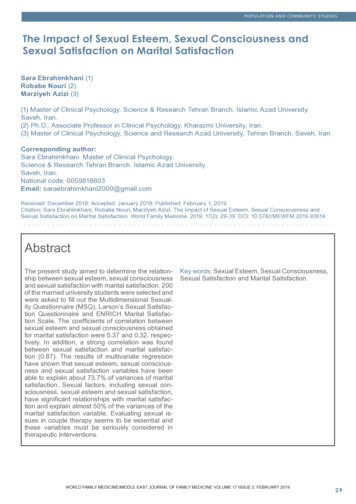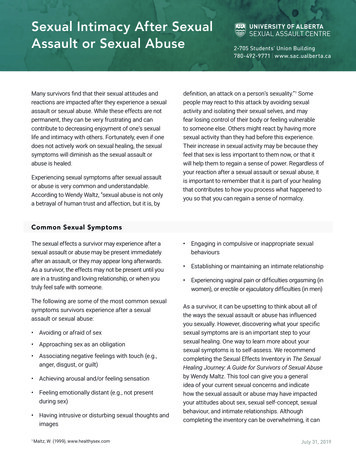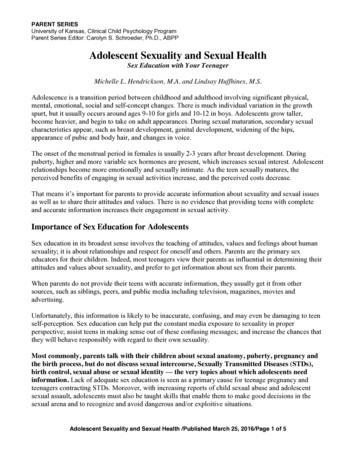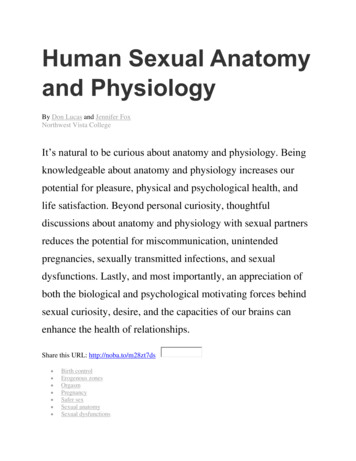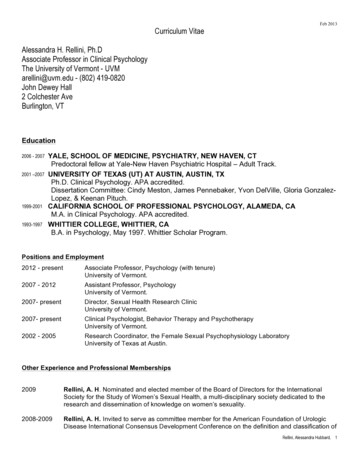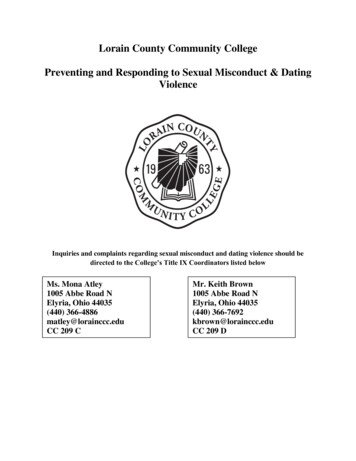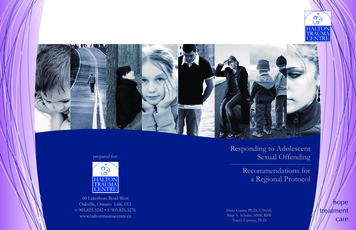
Transcription
Responding to AdolescentSexual OffendingRecommendations fora Regional Protocol
Responding to AdolescentSexual OffendingRecommendations for a Regional ProtocolDana Costin, Ph.D., C.Psych.Siegi A. Schuler, MSW, RSWTracey Curwen, Ph.D.
Preparedby: Dana Costin, Ph.D., C.Psych., Siegi A. Schuler, MSW, RSW, andTracey Curwen, Ph.D. (2009).The opinions expressed in this report are those of the authors and do not necessarilyreflect the views of the Ministry of the Attorney General or the Halton Trauma Centre.For additional copies or comments, contact:Halton Trauma Centre60 Lakeshore Road West, Oakville, Ontario L6K 1E1Telephone: 905.825.3242 Fax: 905.825.3276Web site: www.haltontraumacentre.caE-mail: Info@haltontraumacentre.caContents may not be reproduced for commercial purposes, but any other reproduction,with acknowledgements, is encouraged.
Table of ContentsIntroduction. 1Foreword. 3Background & IntroductionIntrafamilial and Sibling-On-Sibling Sexual Abuse. 5Justification for a Coordinated Protocol. 6Collaboration Among Agencies. 7The Current Project. 8Purpose/Use of this Document. 9Organization of this Document. 9Overview of Protocol.10The Protocol11] Sexual Offence Allegations – Initiate Protocol/Guidelines.11Initiating the Investigation.1112] Residence of the Adolescent/Access to Potentially Vulnerable Individuals.11Adolescent’s Residence – Restrictions/Removal 2.a./2.b.12Adolescent Resides with Victimized Individual(s) 2.c.13Cautionary Note Regarding Separation/Removal of the Adolescent.13Residential Placement of Adolescent.14Victimized Individual’s Wishes.1413] Investigation.15Who is Investigating?.15Police Investigate the Adolescent 3. a.d.f.15Interview of Victimized Individual(s) 3. b.e.15Police/Child Protection Investigate Possible Additional Victims 3.c.16Documentation During Investigation.1614] Victimized Individual’s Status.16New Victimized Individuals Discovered 4.a.16No New Victimized Individuals Discovered 4.b.1615] Access Restrictions/Removal of Adolescent.1716] Assessment of Victimized Individual(s).1717] Charges/Extrajudicial Sanctions/Warnings.1818] Referral of Adolescent for a Comprehensive Assessment.18Parent/Caregiver/Family’s Involvement in Adolescent’s Assessment.19Non-Victimized Siblings.1919] Referral for Treatment.1910] Reunification.20Glossary of Terms.21References.23
The Contributing AuthorsDana Costin, Ph.D., C.Psych.Dr. Costin is a registered Clinical and Forensic Psychologist who specializes in working with children, adolescents,and their families. She has been a member of the Halton Trauma Centre consultation team since 2004. Since 1999,Dr. Costin’s work has focused on assessment and treatment of adolescents who have committed sexual offences, childrenand adolescents who have experienced trauma, children exhibiting sexualized behaviours, adolescents who are inconflict with the law, and their families. In addition to her consultation to the Halton Trauma Centre, Dr. Costin currentlymaintains a private practice, consults to several community-based and residential programs, and consults to the Hospitalfor Sick Children’s Tele-Psychiatry Program. She has also provided training and workshops regarding assessment andtreatment of adolescents who have sexually offended, children exhibiting sexualized behaviours, and children andadolescents who have experienced trauma. With Tracey Curwen, Ph.D., Dr. Costin recently authored a book chapterthat is focused on assessment of children who have engaged in concerning sexual behaviours. Dr. Costin obtained herPh.D. degree at the Ontario Institute for Studies in Education of the University of Toronto (OISE/UT).Siegi A. Schuler, MSW, RSWSiegi is currently the Consulting Clinical Director at the Halton Trauma Centre, a position he has held since 2003. Inaddition to his role with the Halton Trauma Centre, Siegi has maintained a private practice specializing in assessment andtreatment of children and adolescents who have experienced interpersonal trauma and violence, children who displayproblematic sexual behaviour, adolescents who have sexually offended, at-risk youth and youth who are in conflict withthe law, and their families, for the past 16 years. Siegi has also provided training and workshops regarding his areas ofclinical interest, regularly provides consultation with respect to program restructuring and clinical best-practices, andconsults to the Hospital for Sick Children’s Tele-Psychiatry Program. He has lectured in the Faculty of Medicine atMcMaster University and the Faculty of Community Services at Sheridan College. Currently, he is a course instructorand field placement liaison in the Factor Inwentash Faculty of Social Work at the University of Toronto, where he isalso completing his doctoral studies in Social Work.Tracey Curwen, Ph.D.Over the past five years, Tracey has consulted and collaborated with the Halton Trauma Centre on various researchinitiatives. Her most recent project with the Halton Trauma Centre has been an investigation to understand why somechildren who have experienced sexual abuse engage in problematic sexual behaviours while others do not. Tracey startedworking in the field of sexual abuse, sexual aggression, and victimization in 1993. Since that time, she has authoredand co-authored a number of manuscripts on the characteristics of adolescents who have committed sexual offences,treatment outcomes, and risk assessment protocols for children and adolescents with sexual behaviour problems. Traceyobtained a Ph.D. in Developmental Science from the University of Toronto and she is currently Assistant Professorof Psychology at Nipissing University in North Bay, Ontario.
IntroductionIn Canada, only the provinces of British Columbia and Nova Scotia have mandated, coordinated protocols for varioussystems’ responses when adolescent sexual offending has occurred. This document was created out of recognitionof the need for a coordinated, systemic response to adolescent sexual offending in Ontario. It is our position thateffective management of adolescents who commit sexual harm is greatly enhanced by working collaboratively withthe various systems within the adolescent’s circle of care. As such, we have aimed to prepare a document that providesrecommendations for a responding protocol by police, child protection services, and judicial services, from the pointof allegations to referral for assessment and treatment.Although we are aware that the recommendations expressed in this document represent the ideal continuum of care,and that a number of communities may not have the necessary resources available to provide this scope of care orresponse, we believe it is vital to provide communities with information regarding best-practice of care for adolescentswho have sexually offended and their families. It is our belief that implementation of a regional protocol, along thelines of that recommended in this document, will have a direct impact on the protection of our community throughresponsible and ethical treatment of adolescents who have engaged in sexual offences, victimized individuals, andtheir families.AcknowledgementsIn preparing this document, we are grateful for contributions made by the Halton Adolescent Sexual Offence SteeringCommittee, a group of organizations and individuals dedicated to improving a coordinated response to communitysafety. These agencies include the Ministry of Children and Youth Services/Youth Justice, Halton Regional PoliceService – Diversion Program, Halton Children’s Aid Society, and the Reach-Out Centre for Kids (ROCK). Within theseorganizations and agencies, there are numerous dedicated professionals with whom we have developed supportive andcollaborative working relationships, and we are very grateful for these. We would also like to recognize the Ministry ofthe Attorney General for its funding support of this project. Without this investment, this project would not have beenpossible. Thanks, as well, to David Bookalam and Margaret McConnell, for their creativity in developing the layout ofthis document, and to Camilla Graziani for her editorial contribution.Although the Halton Trauma Centre has been delivering specialized services for this population of clients for a relativelyshort period of time, we are extremely fortunate to have recruited a clinical team we believe to be comprised of leaders inthe field of interpersonal abuse, both in terms of clinical practice and research development. We thank the clinicians wework with on a daily basis at the Halton Trauma Centre for their ongoing willingness to share their wisdom, experiences,and expertise. We are particularly grateful to Dr. James R. Worling for his years of training, support, and willingness topass on his extensive knowledge regarding adolescent sexual offending, as well as his thoughtful and invaluable reviewof several drafts of this document.It would not be possible to create this type of document without acknowledging the many adolescents and their familieswith whom we and our colleagues have worked over the years. From these individuals, we have learned that much ispossible when there is hope and a commitment to healing.Page 1
In addition to formalizing a protocol in Ontario as is recommended in this document, the next steps in the developmentof a continuum of care for this field would entail the development of agreed-upon practice standards regarding thetreatment and community reintegration of adolescents who have committed sexual offences. We hope that this documentbecomes a catalyst for other professionals, agencies, and community groups to expand on the recommendations madehere. As we consider this to be an evolving document, we welcome comments and suggestions from those who haveattempted to implement the recommendations we have made.Dana Costin, Ph.D., C.Psych.Consulting Clinical and Forensic PsychologistHalton Trauma CentreSiegi A. Schuler, MSW, RSWConsulting Clinical DirectorHalton Trauma CentreTracey Curwen, Ph.D.Consulting ResearcherHalton Trauma CentreAssistant ProfessorPsychology DepartmentNipissing UniversityDarryl HallExecutive DirectorHalton Trauma CentrePage 2
ForewordAdolescents are responsible for a considerable number of sexual offences in Canada, particularly sexual offences againstyounger children and other teens. Although adolescent sexual offending was historically minimized by both professionalsand the public, it is now known that sexual offences by adolescents are at least as damaging as those perpetrated by adults.The long-term consequences for some people who have been sexually abused can be considerable and, unfortunately,sexual assault continues to be one of the most underreported violent crimes in Canada.With the growing recognition of the importance of addressing adolescent sexual offending, specialized treatmentprograms were developed in the early 1980s in Canada and the United States. When these programs were in theirinfancy, there was very little research or clinical expertise to guide assessment and treatment practices. This was alsothe case for those involved in the legal and child protection fields. As a result, many professionals erroneously reliedon procedures designed for adults who had offended sexually.Fortunately, the last three decades have witnessed a considerable increase in knowledge regarding adolescent sexualoffending. Indeed, there is now research and clinical expertise from around the world to guide investigations, assessments,placement, treatment, and family reunification. There are also several best-practice guidelines that professionals cannow call upon when working with adolescents and their families regarding sexual offending and sexual victimization.Furthermore, there is now research that indicates that specialized treatment significantly reduces the risk of furthersexual and nonsexual reoffending by adolescents.Despite these important scientific and clinical advances, however, there have yet to be any formal protocols to coordinateinvestigation, assessment, and treatment efforts in Ontario. As a result, there are currently tremendous disparities – bothbetween and within the various regions in Ontario. Take, for example, three separate adolescents who have offendedsexually against a much younger child in their community. Within one region, it is possible that one adolescent willbe criminally charged and convicted, removed from the home, and placed in a residential facility for a lengthy periodwithout specialized assessment or treatment. In this same region, another youth may simply be cautioned by authorityfigures. The third adolescent with the same behaviour may be criminally charged and then supported to participatein specialized assessment and treatment while living at home. Of course, there are many other possible variations,including outcomes that involve the adolescent and his or her family receiving treatment services from therapistswithout specialized training or experience. This disparity within any one region in the Province is not unusual, and thereis considerable variability across Ontario as well.This document represents an important first step to address some of these considerable disparities. The authors havestressed the importance of collaborative relationships among child welfare, police, courts, and clinicians, and theyhave carefully outlined a protocol that leads professionals from disclosure to referral for treatment services. It is alsocommendable that the authors have taken care to address the unique issues and struggles that are often involved whenan adolescent has sexually assaulted a younger sibling. The authors have also clearly stressed the need to take a victimcentred approach to working with adolescents who have offended sexually, and they have tied the various steps in theirdetailed protocol to current best-practices in the field.Page 3
This protocol reflects the specialized training and extensive clinical experiences of the authors. The steps outlinedherein should go a long way to ensure that adolescents who offend sexually within one region are dealt with in a similarmanner - and according to current best-practice guidelines. Through more coordinated investigation, assessment, andtreatment efforts, we should ultimately reduce sexual offending by adolescents.Dr. James R. Worling, Ph.D., C.Psych.Clinical and Forensic PsychologistOakville, OntarioPage 4
Responding to Adolescent Sexual Offending – Recommendations for a Regional ProtocolBackground & IntroductionDuring the past several decades, the issue of adolescentsexual offending has received increased clinical, empirical, and legal attention. Research findings havedemonstrated that many adults who have committedsexual offences began offending as adolescents and 50%of adults who have committed sexual offences reportthat they experienced deviant sexual interests prior toage 18 (Barbaree, Hudson, & Seto, 1993). In Canada,20% of those charged with sexual assault are between12 and 17 years of age (Statistics Canada, 2007).implemented in sanctions for youth. While assessmentand treatment options for sexually offending youth arecertainly compatible with the YCJA, these are not alwayspursued.Intrafamilial and Sibling-On-SiblingSexual Abuse:The past two decades have seen a tremendous increasein publications on the subject of family sexual abuse,evidently reflecting society’s growing awareness andrecognition of a problem previously hidden behind a veilof denial, secrecy, and disbelief. While the literature andprofessional community have focused greater attentionon father-daughter incest, there is general agreementthat the most prevalent type of incestuous behaviouroccurs between siblings (Finkelhor, 1990; Lindzey,1967). Furthermore, research findings and clinicalexperiences indicate that sibling incest can be highlyintrusive and often occurs for long periods of time.For example, O’Brien (1991) found that nearly 45% ofsibling offenders had durations of abuse that extendedbeyond one year. It is also noteworthy that opportunityis an essential element in carrying out a sexual assault(Cohen & Felson, 1979). White, Kadlec, and Sechrist(2006) found that sexual assaults by adolescents tendedto occur immediately after school and, on non-schooldays, between 12 pm and 1 pm. Certainly, these timesmay correspond with limited adult supervision.Research regarding sexual offending has demonstrateda relationship between sexual victimization and subsequent sexual offending. Although most survivors ofsexual abuse do not go on to commit sexual offencesthemselves, research findings have consistently demonstrated that significant numbers of individuals whohave sexually offended were sexually victimized duringchildhood or adolescence (Barbaree, Marshall, &McCormick, 1998; Burton & Hedgepeth, 2001; Cooper,Murphy, & Haynes, 1996; Romano & De Luca, 1997;Ryan, Miyoshi, Metzner, Krugman, & Fryer, 1996).Costin (2004) notes that “devoting resources to theissue of sexual offending has the potential to interruptthe victim-to-victimizer phenomenon; decreasing thefrequency of offences and reoffences will reduce thenumber of future victims and this, in turn, will reducethe number of future sexual offenders” (p. 3).In Canada, legal sanctions regarding youth are governedby the Youth Criminal Justice Act (YCJA, 2002).The YCJA (2002) identifies the need for meaningfulconsequences that take into account the young person’sneeds and level of development and “where appropriate,involve the parents, the extended family, the communityand social or other agencies in the young person’srehabilitation and reintegration” (Section 3.c.ii). Afocus on the rehabilitation of young persons is a criticalcomponent of the YCJA, along with the expectationthat the least restrictive means or consequences areWhen legal sanctions include an order for assessment ortreatment of an adolescent who has sexually offended,the implications are often farther reaching than to theadolescent alone. In particular, in cases of intrafamilialsexual abuse (i.e., inclusive of extended family) or,specifically, sibling incest, primary consideration mustbe given to the needs and wishes of the victimizedindividual(s), regardless of the adolescent’s participationin, or completion of, treatment.Page 5Introduction
Responding to Adolescent Sexual Offending – Recommendations for a Regional ProtocolIn certain families, contact withthe offending adolescent may bedetermined to be in the best interestof the victimized sibling(s) or relative(e.g. cousin). Although contact andreintegration will be different forevery family, reunification is a goalfor many families when sibling incestand/or intrafamilial sexual abusehas occurred (Association for theTreatment of Sexual Abusers, 2003).However, not all victimized siblingswill desire or be emotionally capableof resuming contact with the offendingadolescent. As such, in addition toassessing the offending individual’s risk for reoffendingand progress in treatment, as well as the developmentof appropriate safety plans for contact, the practicestandards and guidelines published by the Associationfor the Treatment of Sexual Abusers (2003) stipulatethe need for ensuring the victimized individual’s interestin, and readiness for, reunification. Therefore, in casesof sibling incest and intrafamilial sexual abuse, intensiveassessment and treatment services are necessary for theoffending adolescent, victimized sibling(s)/relative(s), andother family members.Justification for a Coordinated ProtocolWhile the statistics regarding sibling-on-sibling sexualabuse and adolescents who commit sexual offencesagainst children are daunting, and some best-practicesguidelines have been put forward, there are few, if any,mandated protocols and safeguards for victimized childrenand adolescents (or potentially vulnerable individuals) inthese abusive scenarios. Although sexual abuse-focusedorganizations such as the Association for the Treatment ofSexual Abusers (ATSA) and agencies/programs within theGreater Toronto Area have developed empirically guidedbest-practice guidelines in favour of the “best interestof child victim(s)”, there are no regionally mandatedprotocols requiring Children’s Mental Health Agencies,Child Welfare, Police, and Judicial services of Ontario towork collaboratively and consistently with families in theimplementation of these practice standards. In Canada,only the provinces of Nova Scotia and British Columbiahave systemic and coordinated responses to adolescentsexual offending.As a result of the lack of mandated protocols, adolescentswho offend sexually often remain in contact with thechildren they have victimized (or potentially vulnerableindividuals) with few implemented safeguards. In caseswhere precautions are taken regarding only the physicalsafety of victimized children (or potentially vulnerableindividuals), little regard or consideration are given toissues of emotional or psychological safety. In suchcircumstances, children who are victimized sexually maysuffer further psychological impact as a result of the lack ofattention to their emotional fears, reactions, and needs.In its Best Practice Guidelines for Working withChildren, Youth, & Families Who Have ExperiencedAbuse (2004), the Sexual Abuse Treatment Services CityWide Steering Committee within the City of Torontostates that “contact and/or access between a child whohas been abused and the offender must be determinedfollowing a comprehensive process that includes anassessment of the child, family and offender” (p.19). Inaddition, the guidelines state, “prior to family reunificationa number of factors must be considered”. These includebut are not limited to: “ the offender’s ability to takeresponsibility for the abuse and to demonstrate cognitiveand behavioural changes that significantly lower the riskof reoffence and the willingness of the family as a wholeto reunify and follow any rules or restrictions that areimplemented” (p.25). Although these guidelines weredeveloped collaboratively by a number of agencies workingwith sexual abuse, there is no mandate by the various systemsto implement them.IntroductionIn addition to contact issues that arise when adolescentsexual offending has occurred, the lack of mandatedprotocols results in varied and, at times, seeminglyarbitrary responses to allegations. Investigation outcomes,placement/residence decisions, and dispositional outcomesare largely determined by the professional involved and canvary considerably, both from region to region and withinregions. Given the variability in responses, decisions donot consistently integrate and reflect current best-practices.As such, a coordinated protocol for addressing adolescentsexual offending, in both intra- and extrafamilial abusescenarios, is much needed.Page 6
Responding to Adolescent Sexual Offending – Recommendations for a Regional ProtocolIn order to effectively fulfill many of these suggestedcriteria, the roles and responsibilities of those involvedat various levels of the system need to be delineated.Having a clear and consensus-built policy or protocolestablishes the goals for the system and helps jurisdictionsto clearly identify what role each agency will play inaddressing and managing cases of sexual offending(CSOM, 2000b, 2008). Determining and implementingthe various roles and responsibilities requires ongoingcollaboration among those who are responsible forcarrying out various parts of the process (CSOM, 2008).Clearly, a coordinated protocol would address issuesrelated to steps to be taken, roles, responsibilities, andcollaboration.Responding appropriately to sexual offending byadolescents is a multi-level process. This process requiresinvolvement from the many systems that are responsiblefor various aspects of the response such as investigation,adjudication, assessment, treatment, and supervision(Center for Sex Offender Management, CSOM, 2008).According to Talbot, Gilligan, Carter, and Matson (2002),the primary goal of any intervention is preventing futuresexual victimization. These authors, and others, suggest thatreducing recidivism requires multidisciplinary, multi-agency,and collaborative responses on both case managementand policy levels.Those who should be involved in collaboration whena sexual offence has been committed by an adolescentinclude criminal justice system personnel such as judges,crown and defence attorneys, and law enforcementofficers; corrections officials; victim advocates (CSOM,2000a); social service providers; child protection services;and school administration (Talbot et al., 2002). However,coordinating the activities/policies of different stakeholders may be difficult. Therefore, effective interventionrequires cooperation and collaboration among individualsand agencies, as well as a unified goal of protectingvictimized individuals and the community (Colorado SexOffender Management Board, CSOMB, 2003; Talbot etal., 2002).Collaboration Among AgenciesCollaboration amongagencies is vital when anadolescent has been accusedof a sexual offence. Inorder to implement a multisystem and multi-agencycollaboration, it is importantto develop functional andworking relationships(CSOM, 2000a). Accordingto CSOM, functionalrelationships will assist toaddress any misperceptionsor assumptions regarding the roles of other agenciesin the process and enable the clear delineation of rolesfor each provider involved in the process (CSOM,2000a). To date, agency collaboration may have faileddue to a lack of clarity in what others are doing andwho is responsible for specific roles, the belief thatcollaboration may make a job more difficult, a lack ofknowledge and training on issues, and the belief thatcollaboration will not increase efficacy of work (CSOM,2000a). In addition, when performing a task or role, theremay also be a fear of crossing role boundaries (CSOM,2000a). Therefore, clear guidelines and/or protocolsoutlining the responsibility and roles of various agenciesshould eliminate many of the above-mentioned potentialdetractors from successful collaboration.In their writings regarding the accuracy of registereddata regarding adolescent sexual offending, Worlingand Langstrom (2006) have identified a number offactors that can be adapted and applied in interveningappropriately and effectively when an adolescent hasbeen accused of a sexual offence against a sib
for Sick Children's Tele-Psychiatry Program. She has also provided training and workshops regarding assessment and treatment of adolescents who have sexually offended, children exhibiting sexualized behaviours, and children and adolescents who have experienced trauma. With Tracey Curwen, Ph.D., Dr. Costin recently authored a book chapter


